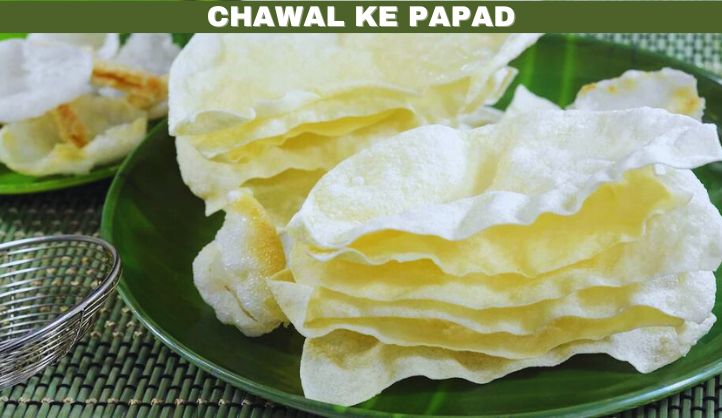In the picturesque landscapes of Uttarakhand, where nature’s bounty thrives, culinary traditions are deeply intertwined with the region’s cultural heritage. Among the array of delightful dishes that adorn the local cuisine,it stand out as a crispy and flavorful delicacy. Join me on a journey as we delve into the world of Chawal ke Papad, uncovering its origins, preparation, and significance in Uttarakhand’s culinary tapestry.
Origins of Chawal ke Papad
Chawal ke Papad, as the name suggests, is made primarily from rice flour, a staple ingredient in Uttarakhand’s cuisine. While the exact origins of Chawal ke Papad are not well-documented, it is believed to have been a traditional preparation passed down through generations in Uttarakhand households. Over time, it has evolved into a popular snack enjoyed not only locally but also by visitors eager to savor the authentic flavors of Uttarakhand.
Preparation Process
The preparation of Chawal ke Papad is a labor of love, requiring skill, patience, and attention to detail. The process begins with soaking rice grains in water to soften them before grinding them into a fine paste. The rice paste is then mixed with spices like cumin, black pepper, and salt to enhance the flavor.
Once the rice flour mixture is ready, it is spread thinly and evenly on clean, dry cloth sheets or trays and left to dry in the sun. The drying process may take several days, depending on the weather conditions. As the rice flour mixture dries, it transforms into thin, translucent sheets that are delicate yet sturdy.
After the sheets have dried completely, they are carefully peeled off the cloth or tray and stored in a cool, dry place until ready to be fried. To prepare Chawal ke Papad for serving, the thin sheets are deep-fried in hot oil until they puff up and turn golden brown. The fried papads are then drained on absorbent paper to remove excess oil and allowed to cool before being served.
Serving and Enjoyment
Chawal ke Papad is best enjoyed fresh and crispy, straight out of the frying pan. It is often served as an accompaniment to meals, particularly during festive occasions and celebrations. The crispy texture and savory flavor of Chawal ke Papad make it an irresistible snack that pairs well with a variety of dishes, from dal-chawal (lentils and rice) to sabzi (vegetable curry) and even as a standalone appetizer.
Significance in Uttarakhand’s Cuisine
Chawal ke Papad holds a special place in Uttarakhand’s culinary landscape, embodying the region’s tradition of using locally sourced ingredients and simple yet flavorful preparations. As a versatile and satisfying snack, Chawal ke Papad is cherished by locals and visitors alike for its crispy texture, savory taste, and nostalgic appeal.
Beyond its culinary significance, Chawal ke Papad also plays a role in preserving cultural heritage and fostering community bonds. The process of making Chawal ke Papad is often a collaborative effort, with family members coming together to prepare and enjoy this beloved snack. In this way, Chawal ke Papad serves as a symbol of unity, tradition, and the joy of sharing food with loved ones.
The Essence of Chawal ke Papad
Chawal ke Papad is not just a snack; it’s a culinary journey through the traditions and flavors of Uttarakhand. As you savor each crispy bite, you’re transported to the sun-kissed fields where rice grains sway gently in the breeze, and to the bustling kitchens where generations have perfected the art of papad making.
Moreover, Chawal ke Papad represents more than just a delicious snack; it symbolizes the resourcefulness and ingenuity of the people of Uttarakhand. In a region where agricultural practices are deeply ingrained in daily life, Chawal ke Papad showcases the inventive ways in which locals utilize staple ingredients to create culinary delights that are both practical and delightful.
Furthermore, Chawal ke Papad serves as a cultural ambassador for Uttarakhand, introducing visitors to the rich tapestry of flavors and traditions that define the region. Whether enjoyed as a crunchy accompaniment to a meal or as a standalone snack, Chawal ke Papad leaves a lasting impression, inviting you to savor the essence of Uttarakhand’s culinary heritage.
Other Famous Dishes in Uttarakhand
1. Kafuli
Kafuli is a traditional dish from Uttarakhand made with spinach (palak) or other leafy greens cooked in a yogurt-based gravy. It is flavored with garlic, ginger, green chilies, and a variety of local spices. Kafuli is known for its creamy texture and vibrant green color, and it is often served with rice or roti.
2. Bhang Ki Chutney
Bhang Ki Chutney is a unique and flavorful chutney made from bhang seeds (hemp seeds), garlic, green chilies, and spices. It has a tangy and slightly bitter taste and is often served as a condiment with snacks or meals in Uttarakhand.
3. Phaanu
Phaanu is a nutritious and hearty lentil curry made from a mix of soaked and ground lentils, including whole urad dal (black gram) and rajma (kidney beans). The lentils are slow-cooked with spices like cumin, coriander, and asafoetida until they form a thick, creamy consistency. Phaanu is typically served with rice and is a popular dish in the Garhwal region of Uttarakhand.
4. Gahat Soup
Gahat Soup, also known as kulath soup, is a traditional soup made from horse gram lentils (gahat). The lentils are cooked with garlic, ginger, onions, tomatoes, and spices like cumin and coriander until they are soft and flavorful. Gahat Soup is often enjoyed as a comforting and nourishing dish, especially during cold winter months.
5. Bhatt Ki Churkani
Bhatt Ki Churkani is a flavorful curry made from black soybeans (Bhatt), which are native to the hills of Uttarakhand. The beans are soaked overnight and then cooked with spices like cumin, coriander, and ginger-garlic paste until they are soft and creamy. Bhatt Ki Churdkani is often served with rice or roti for a hearty and nutritious meal.
6. Arsa
Arsa is a traditional sweet delicacy made from soaked rice, jaggery (or sugar), and ghee. The ingredients are mixed to form a dough, which is then shaped into small round balls and deep-fried until golden brown. Arsa has a crispy exterior and a soft, chewy interior, making it a popular sweet treat during festivals and special occasions in Uttarakhand.
Conclusion
In the vibrant tapestry of Uttarakhand’s culinary traditions, Chawal ke Papad shines as a crispy and flavorful delight that captures the essence of the region’s rich heritage. From its humble origins in household kitchens to its status as a beloved snack enjoyed by all, Chawal ke Papad embodies the warmth, hospitality, and timeless appeal of Uttarakhand’s culinary treasures. So the next time you find yourself in the hills of Uttarakhand, be sure to indulge in the crispy goodness of Chawal ke Papad for a truly authentic taste of the region.
FAQs About Chawal ke Papad
1. What is Chawal ke Papad?
Chawal ke Papad is a crispy, thin disc-shaped snack made primarily from rice flour. It is a popular delicacy in Uttarakhand and other parts of India, often enjoyed as a crunchy accompaniment to meals or as a standalone snack.
2. How is Chawal ke Papad made?
Chawal ke Papad is made by soaking rice grains in water to soften them and then grinding them into a fine paste. The rice paste is mixed with spices like cumin, black pepper, and salt, and then spread thinly and evenly on clean, dry cloth sheets or trays. The thin sheets are dried in the sun until they become crisp, after which they are fried until golden brown and crispy.
3. What spices are used in Chawal ke Papad?
The spices used in Chawal ke Papad may vary depending on personal preference and regional variations. Common spices include cumin seeds, black pepper, salt, and sometimes chili powder or other flavorful spices to add a kick of heat.
4. How is Chawal ke Papad served?
Chawal ke Papad is typically served as a crunchy accompaniment to meals, especially in Uttarakhand and other parts of North India. It pairs well with dal (lentil curry), sabzi (vegetable curry), rice, and roti. It can also be enjoyed as a standalone snack with a cup of tea or as an appetizer before a meal.
5. Can Chawal ke Papad be stored for later use?
Yes, Chawal ke Papad can be stored in an airtight container in a cool, dry place for several weeks or even months. However, it is best to consume them within a reasonable time frame to ensure optimal freshness and crispiness.
6. Is Chawal ke Papad gluten-free?
Yes, Chawal ke Papad is gluten-free since it is made primarily from rice flour, which does not contain gluten. It is a suitable snack option for individuals with gluten intolerance or celiac disease.





